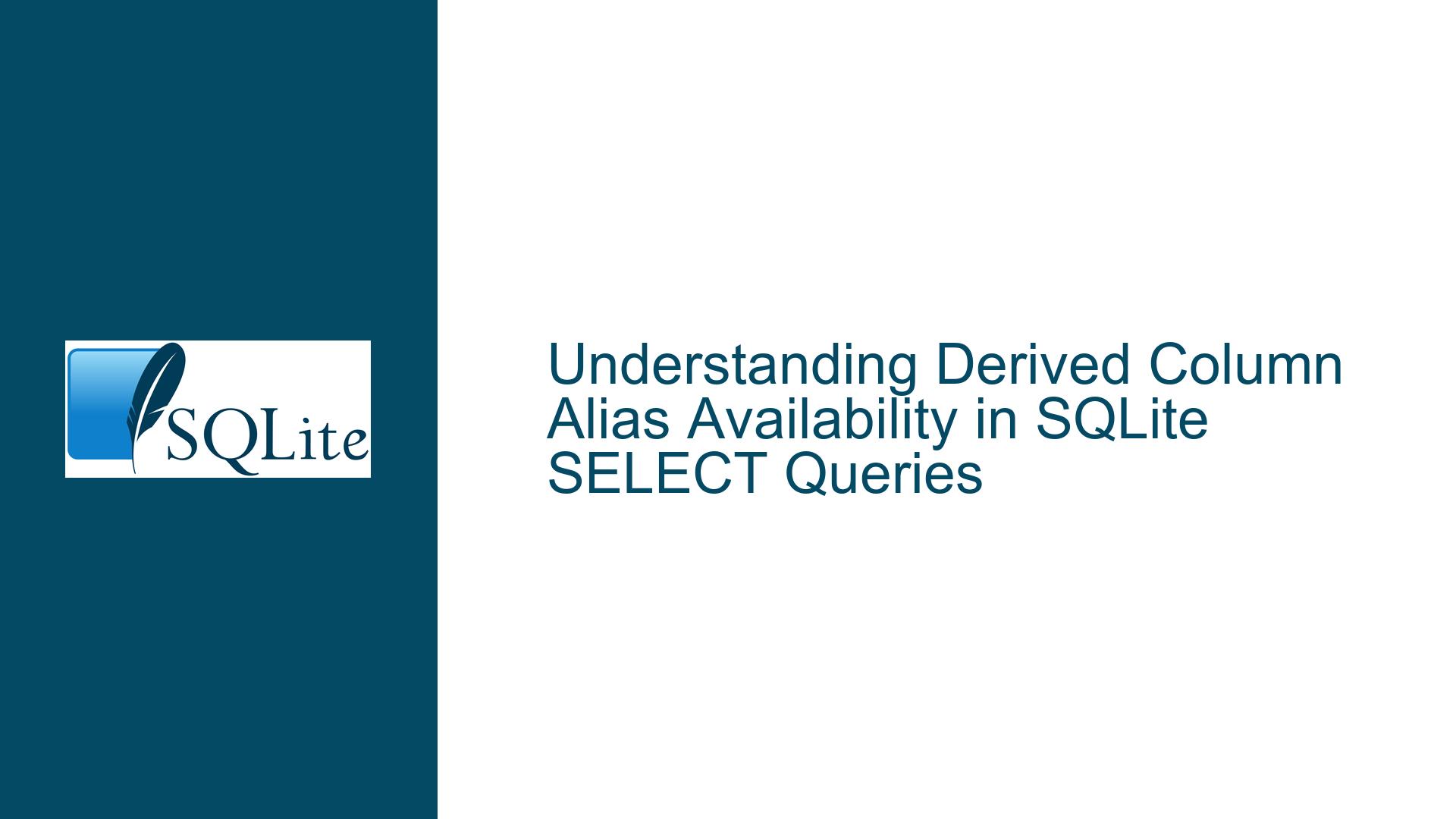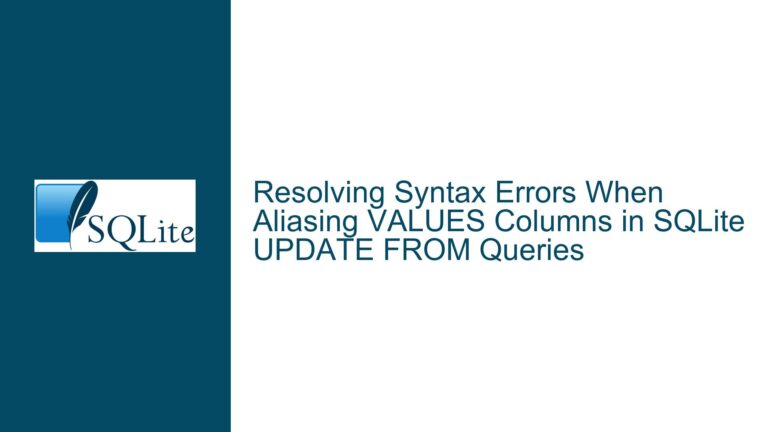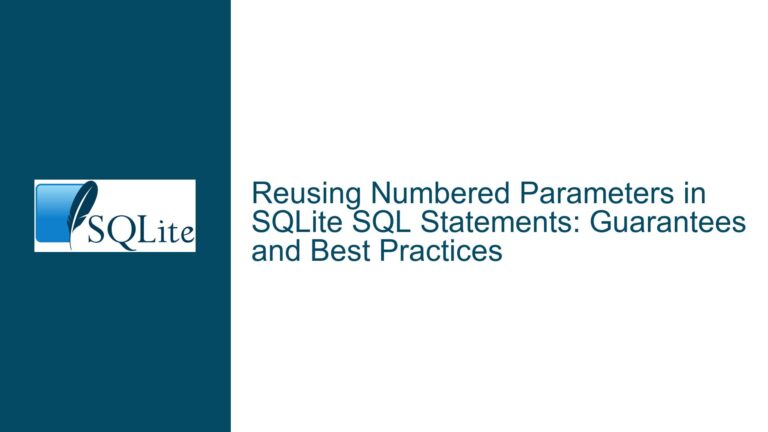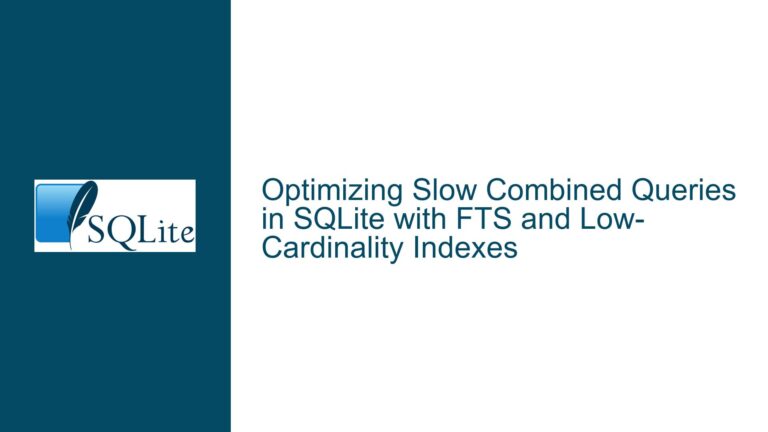Derived Column Alias Availability in SQLite SELECT Queries
Derived Column Alias Scope Limitations in SELECT Statements
SQLite’s Column Alias Visibility Rules
The core issue revolves around when and where derived column aliases become visible within a SQLite query. SQLite follows a strict sequence of operations when processing queries:
- FROM/JOIN clause evaluation
- WHERE clause filtering
- GROUP BY aggregation
- HAVING clause filtering
- SELECT column computation (including aliases)
- ORDER BY sorting
This sequence explains why the alias replacement in the first query works in the ORDER BY clause but first_bracket fails in the SELECT clause of the second query. Column aliases defined in the SELECT list are not visible within the same SELECT list because they are computed after the SELECT phase. The ORDER BY clause, however, operates after the SELECT phase, allowing it to reference aliases.
In the problematic query:
SELECT DISTINCT album,
iif(...) AS first_bracket,
substr(album, 1, first_bracket - 2)
FROM alib ...
The expression first_bracket - 2 attempts to reference the alias first_bracket within the same SELECT list. Since first_bracket has not yet been materialized (it is part of the same computation phase), SQLite throws a "no such column" error. This is distinct from the first query, where replacement is referenced in ORDER BY, a later processing stage.
Implications of Expression Reusability and Code Duplication
The root cause is expression dependency within the same logical processing phase. SQLite does not support forward references to column aliases in the SELECT list because of its single-pass evaluation strategy. This limitation forces developers to choose between:
- Repeating complex expressions (violating DRY principles)
- Using subqueries or CTEs to materialize intermediate results
- Leveraging correlated subqueries for on-demand computation
The original query’s iif(...) logic computes the position of the first bracket (( or [). Reusing this result in substr(...) requires that the value be available before the SELECT list completes computation. SQLite’s architecture makes this impossible without structural changes to the query.
Consider the expression:
iif(instr(album, '(') > instr(album, '['), instr(album, '('), instr(album, '['))
Repeating this in both the first_bracket alias and the substr(...) function would double the computational overhead. For large datasets, this could degrade performance.
Materializing Intermediate Results via Subqueries and CTEs
To resolve the alias visibility issue, intermediate results must be materialized in a separate processing stage. Two primary approaches exist:
1. Common Table Expressions (CTEs)
The WITH clause creates a temporary result set that persists for the duration of the query. Aliases defined in the CTE become columns in the temporary table, making them visible to subsequent parts of the query:
WITH with_first_bracket AS (
SELECT DISTINCT
album,
iif(instr(album, '(') > instr(album, '['), instr(album, '('), instr(album, '[')) AS first_bracket
FROM alib
WHERE instr(album, '(') > 1 OR instr(album, '[') > 1
)
SELECT
album,
first_bracket,
substr(album, 1, first_bracket - 2)
FROM with_first_bracket
ORDER BY album;
Here, the CTE with_first_bracket computes first_bracket in a separate SELECT phase. The outer query then treats first_bracket as a regular column, enabling its use in substr(...).
Advantages:
- Eliminates expression repetition.
- Enhances readability by separating concerns.
- Compatible with all SQLite versions supporting CTEs (v3.8.3+).
Disadvantages:
- May incur temporary storage overhead for large datasets.
- CTEs are optimization fences in some databases; SQLite’s optimizer can flatten CTEs, but complex cases may not benefit from index usage.
2. Inline Subqueries
Rewriting the query with an inline subquery avoids CTEs:
SELECT
album,
first_bracket,
substr(album, 1, first_bracket - 2)
FROM (
SELECT DISTINCT
album,
iif(instr(album, '(') > instr(album, '['), instr(album, '('), instr(album, '[')) AS first_bracket
FROM alib
WHERE instr(album, '(') > 1 OR instr(album, '[') > 1
) AS subquery
ORDER BY album;
This achieves the same result as the CTE approach by nesting the SELECT statement.
Advantages:
- Works in older SQLite versions without CTE support.
- Often more performant for simple transformations due to reduced parsing overhead.
Disadvantages:
- Less readable for deeply nested logic.
3. Correlated Subqueries
Gunter Hick’s suggestion involves computing first_bracket dynamically for each row:
SELECT DISTINCT
album,
(SELECT iif(instr(album, '(') > instr(album, '['), instr(album, '('), instr(album, '['))) AS first_bracket,
substr(album, 1, (SELECT iif(...)) - 2)
FROM alib
WHERE instr(album, '(') > 1 OR instr(album, '[') > 1
ORDER BY album;
This approach recalculates first_bracket for both the alias and the substr(...) function.
Advantages:
- No structural changes to the query.
Disadvantages:
- Repeats the
iif(...)logic, violating DRY principles. - Doubles computational cost for large datasets.
4. Expression Factoring with CROSS JOIN
For queries requiring multiple derived columns, use CROSS JOIN to compute values once:
SELECT
album,
first_bracket,
substr(album, 1, first_bracket - 2)
FROM alib
CROSS JOIN (
SELECT iif(instr(album, '(') > instr(album, '['), instr(album, '('), instr(album, '[')) AS first_bracket
)
WHERE instr(album, '(') > 1 OR instr(album, '[') > 1
ORDER BY album;
Note: This pseudocode illustrates the concept but may require adjustment for context-dependent column references.
Optimization Considerations and Best Practices
Indexing Strategy
Frequent use of instr(album, '(') suggests that optimizing string searches could improve performance. However, SQLite lacks built-in indexing for substring searches. Workarounds include:
- Persisted Computed Columns (SQLite 3.31.0+):
CREATE TABLE alib (
album TEXT,
first_bracket INTEGER GENERATED ALWAYS AS (iif(instr(album, '(') > instr(album, '['), instr(album, '('), instr(album, '[')))
);
This allows indexing first_bracket:
CREATE INDEX idx_alib_first_bracket ON alib(first_bracket);
Query Simplification
Rewrite the iif(...) logic using CASE for clarity:
CASE
WHEN instr(album, '(') > instr(album, '[') THEN instr(album, '(')
ELSE instr(album, '[')
END AS first_bracket
Benchmarking Approaches
Test each method with EXPLAIN QUERY PLAN to compare execution steps:
EXPLAIN QUERY PLAN
WITH ... -- CTE approach
vs.
EXPLAIN QUERY PLAN
SELECT ... -- Inline subquery approach
Final Recommendations
Use CTEs for Readability and Maintainability:
Adopt theWITHclause approach for complex queries where intermediate results improve clarity.Prevent Expression Repetition:
Avoid correlated subqueries that duplicate logic unless performance testing shows negligible impact.Index Computed Columns:
For heavily queried derived values, use persisted generated columns (if SQLite version ≥3.31.0).Profile Query Performance:
UseEXPLAIN QUERY PLANand runtime testing to choose between CTEs, subqueries, and temporary tables.
By materializing derived columns in CTEs or subqueries, you align with SQLite’s processing model while maintaining code efficiency and readability.






